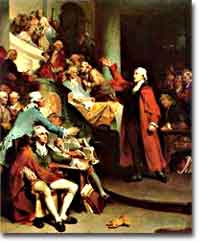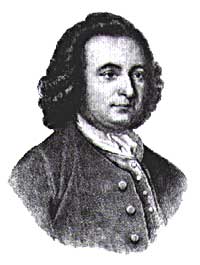16b. Antifederalists

Patrick Henry delivers his famous "If this be treason, make the most of it!" speech to the Virginia House of Burgesses.
The Antifederalists were a diverse coalition of people who opposed ratification of the Constitution. Although less well organized than the Federalists, they also had an impressive group of leaders who were especially prominent in state politics.
Ranging from political elites like James Winthrop in Massachusetts to Melancton Smith of New York and Patrick Henry and George Mason of Virginia, these Antifederalist were joined by a large number of ordinary Americans particularly yeomen farmers who predominated in rural America. The one overriding social characteristic of the Antifederalists as a group was their strength in newer settled western regions of the country.

On August 31, 1787, George Mason declared he would "rather chop off my right hand than put it to the Constitution as it now stands."
In spite of the diversity that characterized the Antifederalist opposition, they did share a core view of American politics. They believed that the greatest threat to the future of the United States lay in the government's potential to become corrupt and seize more and more power until its tyrannical rule completely dominated the people. Having just succeeded in rejecting what they saw as the tyranny of British power, such threats were seen as a very real part of political life.
To Antifederalists the proposed Constitution threatened to lead the United States down an all-too-familiar road of political corruption. All three branches of the new central government threatened Antifederalists' traditional belief in the importance of restraining government power.
The President's vast new powers, especially a veto that could overturn decisions of the people's representatives in the legislature, were especially disturbing. The court system of the national government appeared likely to encroach on local courts. Meanwhile, the proposed lower house of the legislature would have so few members that only elites were likely to be elected. Furthermore, they would represent people from such a large area that they couldn't really know their own constituents. The fifty-five members of the proposed national House of Representatives was quite a bit smaller than most state legislatures in the period. Since the new legislature was to have increased fiscal authority, especially the right to raise taxes, the Antifederalists feared that before long Congress would pass oppressive taxes that they would enforce by creating a standing national army.

The preamble of the United States Constitution: Most of the world's democracies have based their constitutions on this document.
This range of objections boiled down to a central opposition to the sweeping new powers of the proposed central government. George Mason, a delegate to the Philadelphia Convention who refused to support the Constitution, explained, the plan was "totally subversive of every principle which has hitherto governed us. This power is calculated to annihilate totally the state governments." The rise of national power at the expense of state power was a common feature of Antifederalist opposition.
The most powerful objection raised by the Antifederalists, however, hinged on the lack of protection for individual liberties in the Constitution. Most of the state constitutions of the era had built on the Virginia model that included an explicit protection of individual rights that could not be intruded upon by the state. This was seen as a central safeguard of people's rights and was considered a major Revolutionary improvement over the unwritten protections of the British constitution.
Why, then, had the delegates to the Philadelphia Convention not included a bill of rights in their proposed Constitution? Most Antifederalists thought that such protections were not granted because the Federalists represented a sinister movement to roll back the gains made for ordinary people during the Revolution.
The Antifederalists and Federalists agreed on one thing: the future of the nation was at stake in the contest over the Constitution.






